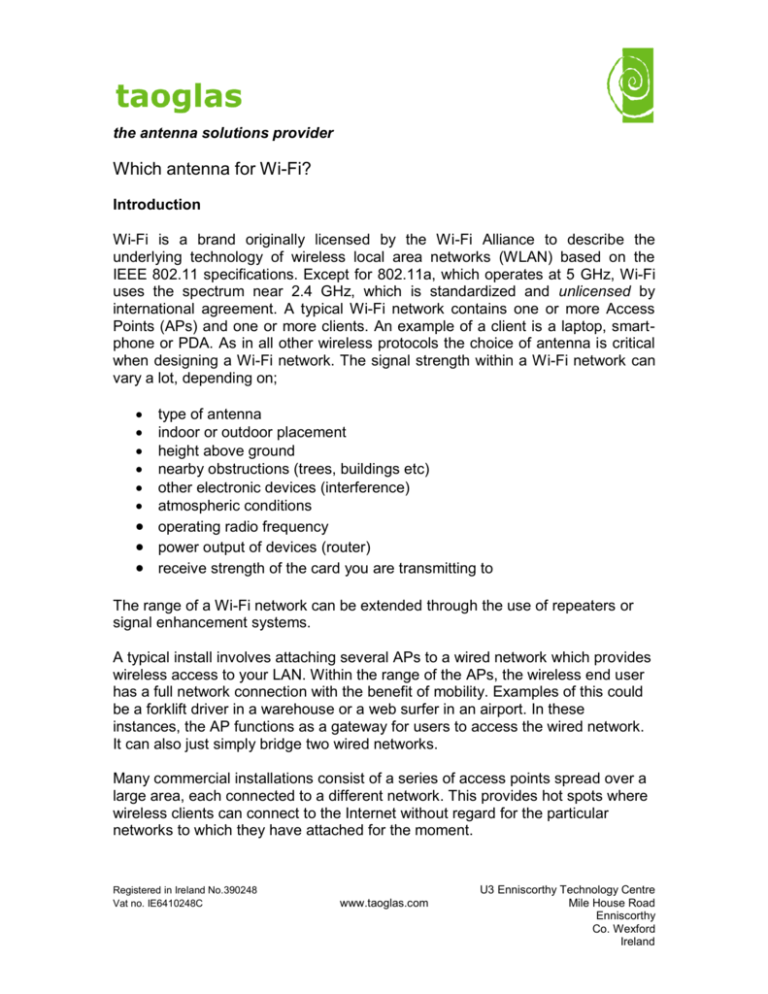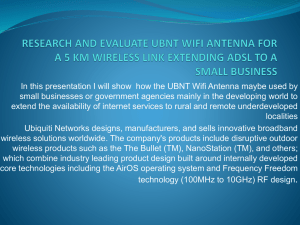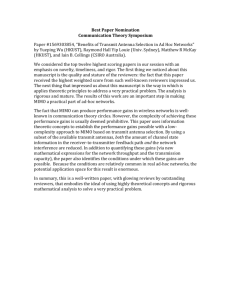Which WIFI Antenna
advertisement

the antenna solutions provider Which antenna for Wi-Fi? Introduction Wi-Fi is a brand originally licensed by the Wi-Fi Alliance to describe the underlying technology of wireless local area networks (WLAN) based on the IEEE 802.11 specifications. Except for 802.11a, which operates at 5 GHz, Wi-Fi uses the spectrum near 2.4 GHz, which is standardized and unlicensed by international agreement. A typical Wi-Fi network contains one or more Access Points (APs) and one or more clients. An example of a client is a laptop, smartphone or PDA. As in all other wireless protocols the choice of antenna is critical when designing a Wi-Fi network. The signal strength within a Wi-Fi network can vary a lot, depending on; type of antenna indoor or outdoor placement height above ground nearby obstructions (trees, buildings etc) other electronic devices (interference) atmospheric conditions operating radio frequency power output of devices (router) receive strength of the card you are transmitting to The range of a Wi-Fi network can be extended through the use of repeaters or signal enhancement systems. A typical install involves attaching several APs to a wired network which provides wireless access to your LAN. Within the range of the APs, the wireless end user has a full network connection with the benefit of mobility. Examples of this could be a forklift driver in a warehouse or a web surfer in an airport. In these instances, the AP functions as a gateway for users to access the wired network. It can also just simply bridge two wired networks. Many commercial installations consist of a series of access points spread over a large area, each connected to a different network. This provides hot spots where wireless clients can connect to the Internet without regard for the particular networks to which they have attached for the moment. Registered in Ireland No.390248 Vat no. IE6410248C www.taoglas.com U3 Enniscorthy Technology Centre Mile House Road Enniscorthy Co. Wexford Ireland the antenna solutions provider Like all radio waves at RF, any obstruction between the transmitting and receiving antennas will attenuate/reflect/diffract the signal, just like the light that the eye senses. Because Wi-Fi utilises line of sight (LOS) propagation it is imperative that the optimum signal strength is available to the receiver from the transmitting antenna. Because WLAN is dependant on operating frequency means that 802.11b/g (i.e. 2.4 GHz) exhibit better range than that of 802.11a (5 GHz). The Wi-Fi standard leaves connection criteria and roaming totally open to the client, which is strength of Wi-Fi, but also means that one wireless adapter may perform substantially better than another. Since Wi-Fi transmits in free space, it has the same properties as a non-switched Ethernet network. Even collisions can therefore appear as in non-switched Ethernet LAN's. This is not the case however for 802.11a, which operates at 5 GHz. 802.11b/g uses the spectrum near 2.4 GHz, which is standardized and unlicensed by international agreement, although the exact frequency allocations vary slightly in different parts of the world, as does maximum permitted power. However, channel numbers are standardized by frequency throughout the world, so authorized frequencies can be identified by channel numbers. The frequencies for 802.11 b/g span 2.400 GHz to 2.487 GHz. Each channel is 22 MHz wide yet there is a 5 MHz step to the next higher channel (this is known as a guard band). The maximum number of available channels for Wi-Fi enabled devices is 13 for Europe, 11 for North America and 14 for Japan. Wi-Fi networks have limited range dependant on the network topology, i.e. how many APs there are. Before choosing consider….. You can improve your range with antenna choice and also by choosing line-ofsight, directional antennas. With all antenna technologies bigger gives you more! The amount of gain required will depend on; WLAN environment Distance between APs and clients AP output power/receiver sensitivity An antenna with good gain should be chosen. In fact as the power output of the WLAN card is extremely small it is best to have as much gain as possible. Most WLAN cards have a power output of 32 milliwatts (+15dBm) – but note the output power is restricted by the IEEE 802.11 standards. That will suffice for a small Registered in Ireland No.390248 Vat no. IE6410248C www.taoglas.com U3 Enniscorthy Technology Centre Mile House Road Enniscorthy Co. Wexford Ireland the antenna solutions provider area, but not enough for a large distance or through a building. This is why the antenna is critical for increasing the signal range. Also consider the noise level present in the wireless network. The larger the signal strength the better the signal to noise ratio (SNR) will be at the input to the WLAN card. Directional antennas are used for Point-to-Point or sometimes for Multi-Point systems depending on the setup. If you are trying to go from one location (say for instance your router), to another location, this is the type of antenna we recommend. So which antenna? Taoglas 2.4GHz 2dBi External Antenna range These are the small black stick like antennas that simply screw into the back of your router. They are perfect for „home/small office‟ installations. One antenna may be required on every computer but the signal will not travel outside your building. Each wall will weaken the signal. Taoglas 2.4GHz High Gain External Antenna range Eliminate cables inside your office with an efficient wireless card and a high gain antenna from this range. These higher gain antennas result in an increased network speed (i.e. bandwidth). They can also be used to simply extend your range further than the previous offering. Registered in Ireland No.390248 Vat no. IE6410248C www.taoglas.com U3 Enniscorthy Technology Centre Mile House Road Enniscorthy Co. Wexford Ireland the antenna solutions provider Taoglas 2.4 GHZ Panel Antenna range These are small, discreet directional antennas with excellent gain. Strongly recommended for point to point, or multipoint systems due to the ease and speed of install in locations where covertness is desired. They have excellent gain and are high performing antennas. The antenna inside has been tuned specific to its structure. Taoglas 2.4 GHZ Yagi Grid Extremely directional antennas and are generally used to extend range (miles) to a specific point in a system. We don‟t recommend these unless the panel antenna‟s range has failed in a system to a certain location. Taoglas 2.4 GHZ Omni (white fibreglass pole type) range Omni directional antennas are common “Base” antennas used for Point-to-MultiPoint systems (for sharing a WLAN or a high-speed internet connection inside a building or within close range). An Omni-Directional antenna would serve as your main antenna to distribute the signal to other computers. You could choose two Omni-Directional antennas for a point to point system, but this is usually not Registered in Ireland No.390248 Vat no. IE6410248C www.taoglas.com U3 Enniscorthy Technology Centre Mile House Road Enniscorthy Co. Wexford Ireland the antenna solutions provider recommended because there is no real point to distributing your signal all over the place when you only want to going from one point to another. Taoglas 2.4 GHZ Parabolic Dish & Dish range High gain antennas perfect for long distances. This is for when you really need to power up the gain! However please consider that you also decrease the radiation pattern when you do this so only use for long point to point systems. I am sure you will as the price reflects the strength! Taoglas 2.4GHz Magnetic Mount antenna Finally this is used for quick convenient installations – mobile installs mainly. Registered in Ireland No.390248 Vat no. IE6410248C www.taoglas.com U3 Enniscorthy Technology Centre Mile House Road Enniscorthy Co. Wexford Ireland



